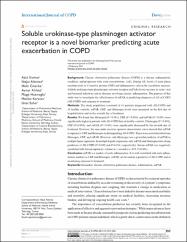Soluble urokinase-type plasminogen activator receptor is a novel biomarker predicting acute exacerbation in COPD

Göster/
Erişim
info:eu-repo/semantics/openAccessTarih
2015Yazar
Gümüş, AzizAltıntaş, Nejat
Çinarka, Halit
Kırbaş, Aynur
Hazıroğlu, Müge
Karatas, Mevlüt
Şahin, Ünal
Üst veri
Tüm öğe kaydını gösterKünye
Gumus, A., Altintas, N., Cinarka, H., Kirbas, A., Haziroglu, M., Karatas, M., Sahin, U. (2015). Soluble urokinase-type plasminogen activator receptor is a novel biomarker predicting acute exacerbation in COPD. International Journal of Chronic Obstructive Pulmonary Disease, 10, 357-365. https://doi.org/10.2147/COPD.S77654Özet
Background: Chronic obstructive pulmonary disease (COPD) is a chronic inflammatory condition, and progresses with acute exacerbations. (AE). During AE, levels of acute phase reactants such as C-reactive protein (CRP) and inflammatory cells in the circulation increase. Soluble urokinase-type plasminogen activator receptor (suPAR) levels increase in acute viral and bacterial infections and in diseases involving chronic inflammation. the purpose of this study was to investigate the effectiveness of suPAR in predicting diagnosis of AE of COPD (AE-COPD) and response to treatment. Methods: the study population consisted of 43 patients diagnosed with AE-COPD and 30 healthy controls. suPAR, CRP, and fibrinogen levels were measured on the first day of hospitalization and on the seventh day of treatment. Results: We found that fibrinogen (P<0.001), CRP (P<0.001), and suPAR (P<0.001) were significantly higher in patients with AE-COPD than in healthy controls. Fibrinogen (P<0.001), CRP (P=0.001), and suPAR (P<0.001) were significantly decreased by the seventh day of treatment. However, the area under receiver operator characteristic curve showed that suPAR is superior to CRP and fibrinogen in distinguishing AE-COPD. There was a correlation between fibrinogen, CRP, and suPAR. However, only fibrinogen was a powerful predictor of suPAR in multiple linear regression. in multiple logistic regression, only suPAR and fibrinogen were strong predictors of AE-COPD (P=0.002 and P=0.014, respectively). Serum suPAR was negatively correlated with forced expiratory volume in 1 second (r=-478, P=0.001). Conclusion: suPAR is a marker of acute inflammation. It is well correlated with such inflammation markers as CRP and fibrinogen. suPAR can be used as a predictor of AE-COPD and in monitoring response to treatment.

















